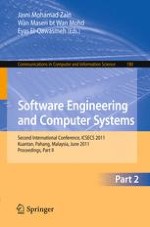This Three-Volume-Set constitutes the refereed proceedings of the Second International Conference on Software Engineering and Computer Systems, ICSECS 2011, held in Kuantan, Malaysia, in June 2011. The 190 revised full papers presented together with invited papers in the three volumes were carefully reviewed and selected from numerous submissions. The papers are organized in topical sections on software engineering; network; bioinformatics and e-health; biometrics technologies; Web engineering; neural network; parallel and distributed e-learning; ontology; image processing; information and data management; engineering; software security; graphics and multimedia; databases; algorithms; signal processing; software design/testing; e- technology; ad hoc networks; social networks; software process modeling; miscellaneous topics in software engineering and computer systems.
